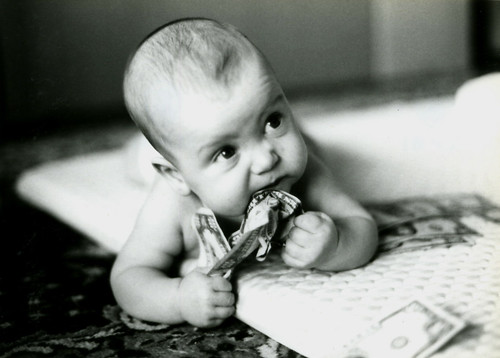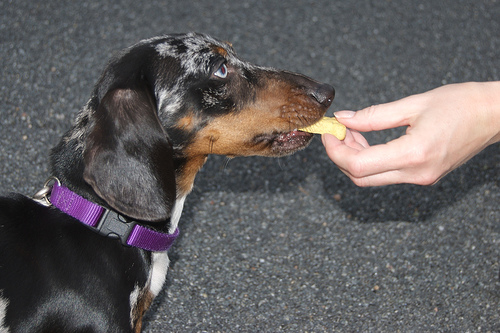What would your future-you have to say to you?
The no-pants guide to spending, saving, and thriving in the real world.
What would your future-you have to say to you?
From the comments here. The discussion is on how much it costs to have a baby. Edited for clarity.
 Babies” width=”270″ height=”200″ />
Babies” width=”270″ height=”200″ />
Actual birthing costs vary. We’ve had three kids over ten years and birthing costs have varied from $250 out of pocket to $8500. Our highest and lowest price births were 20 months apart. The highest price birth involved induced labor with an epidural. For the lowest out-of-pocket price, I added my wife to my policy before the birth, so she was double-covered. If one of your policies is less than ideal and there are multiple policies available, I recommend doing this. It saved us thousands. All told, If things go well, you could slide for as little as $1500 total.
For the highest price birth, we threw ourselves on the mercy of the finance department. They have a charity fund to pay the bills of the less fortunate. We qualified…barely. If you have a medical bill you can’t afford, ask if there is a grant or donation you can apply for. Always ask if there is some way the bill could be lowered.
Breast-feeding beats the heck out of formula, financially, but breast-feeding doesn’t always work. Ignore the boob-nazis who insist you are slowly killing your kid by using formula. I’ve got 3 kids, and each had different feeding issues.
Baby formula runs $19 for a big container at Sam’s Club, or a large percentage of your soul at most other big box stores. Formula alone will pay for your membership in under a month. For a big eater, that’s $20-30 per week. For a normal eater, 2-3 weeks. For planning purposes, assume $100/month in formula costs for the first six months, when food starts coming into play heavily. After that, the formula expense goes down, but not away for at least 6 more months.
Diapers are painful. Not just the smell–though that hurts, too, sometimes–but the expense. I currently have 2 in diapers; one is potty-training. Our monthly costs for diapers, now, are about $75. It was easily twice that when they were younger. Figure at least $100 per month in diapers. Unless your baby has irritation problems, go with cheap diapers. Leak-guard is a joke. If you are relying on leak-guard to keep the contents inside the diaper, you aren’t changing your baby often enough.
I couldn’t begin to guess at how much you’ll spend on baby clothes. I have never bought clothes for our kids. Whatever didn’t come free from friends and family walked into the house of it’s own volition, following my wife home from the store.
Toys are an almost purely voluntary expense. You’ll get as much as the kids needs free, as presents. You’ll go overboard and give the kids 10 times that, without realizing it. Don’t. For the first four to five months, its fingers and toes will be entertaining enough. After that, if there are more than about ten toys, it’s too many; the kid will never get attached to any of them. Keep it small. It’s better for the kids and the budget. Little kids prefer boxes to toys, anyway. Give the kid a shoebox instead of a Leapfrog. Really.
Portraits suck, too. If you have to get them done professionally, get a membership that covers sitting fees, and use coupons. I recommend JC Penney’s. Using judicious coupons and the membership, we get portraits for under $20.
Baby food is probably cheaper to make in a food processor, but you can’t beat the convenience of the little jars. If you watch sales, you can stock up affordably. Mix every meal with some rice or oatmeal mush to stretch it, without making it unhealthy. Depending on your kids, and how much you listen to the “experts”, this is a nonexistent expense before six months. Our kids started eating baby food in their second months, at least a little bit.
Babies are expensive. Don’t doubt that for a second, but ignore the polled averages when it comes to expense. Hand-me-downs, thrift stores, and good sales cut the expense a lot.
How do you save money and value with a baby in the house?


What’s the difference between a bribe and a reward? It’s a question that has been heavily on my mind lately. As a father of three–1, 3 and 10–motivating children occupies a lot of my thoughts. Is it possible to motivate a child and reward good behavior without resorting to a bribe?
First, let’s look at the definitions:
bribe n.
1. Something, such as money or a favor, offered or given to a person in a position of trust to influence that person’s views or conduct.
2. Something serving to influence or persuade.
re·ward n.
1. Something given or received in recompense for worthy behavior or in retribution for evil acts.
2. Money offered or given for some special service, such as the return of a lost article or the capture of a criminal.
3. A satisfying return or result; profit.
4. Psychology: The return for performance of a desired behavior; positive reinforcement.
In my mind, a reward is given either as a goal for planned activity or a surprise for good behavior. When used for surprises, it should never be common enough to be expected. If a child is only behaving because she is expecting a reward, it is bribed behavior. She should always be surprised to get the reward.
Using a reward for goal setting is no different than collecting a paycheck. Is my company bribing me to do the work I do every day? They plan to reward or compensate me for the work I plan to do for them. While that my be blurring the line between compensation and rewards, it is valid. My future paycheck is the motivation for my current work.
Bribes, on the other hand, are reward for bad behavior. If my three-year-old is throwing a tantrum in the grocery store and I promise her candy to stop, I have just taught her that the “reward” for a public tantrum is candy. This is reinforcing negative behavior, which will only escalate in the future. If a temper tantrum earns a candy bar, what will she get for hitting Mommy with a frying pan?
The line is further blurred by preemptive bribes. If I tell my children there will be candy when we get home if they behave in the store, it’s still a bribe. Promising dessert if my son cleans his room is a bribe.
So what is the difference?
Bribes reward negative behavior. Whether that is actual behavior or anticipated behavior, bribes provide a reward for it. If you use a treat to end or preempt bad actions, you are bribing your child.
Rewards celebrate positive behavior. A promised treat for going beyond expectations or a surprise for excellent behavior is a reward. It should never become common, or the child will discover that withholding the positive behavior will generate promises of larger rewards. The goal is to reinforce the good to encourage positive behaviors even when there is no likelihood for reward.
For example, my son’s school is part of a reading contest. Over a two month period, if the students read 500 pages outside of school, they will get tickets to a basketball game. If they are in the top three for pages read, they will get personalize jerseys and on-court recognition. My son did the math and was reading enough to surpass the 500 page goal, but not enough to get into the top three. I offered a prize if he made it to 2500 pages. In my opinion, that’s a reward. He was already going beyond the requirement. I have provided motivation to push himself beyond what he thinks he can do. That’s positive reinforcement of good behavior.
On the other hand, when my eight-year-old was refusing to eat dinner, we offered a cookie for dessert if she ate well. That’s reinforcing negative behavior by giving a reward for misbehaving. A bribe.
Rewards are positive responses to positive behavior to motivate future good behavior. Bribes are rewards for negative behavior, real or anticipated, that only serve to encourage more bad behavior in the future.
This month, I have two 30 Day Projects.
My first project is to start waking up at 5am. This will add an extra 90 minutes to my day, which will give me time to manage all of my other 30 day projects. I’ll be able to wake up to a quiet house, walk the dog, eat breakfast and not start every day in a rush to get out of the house. Today was my exception. After watching 2010 arrive, I didn’t get up early.
The second project is to start reading to my children every night before bed. We read to the kids often, but not every day. That’s going to change. We are also working on breaking the girls of the family bed. If I can read them to sleep each night, it will help. Good, educational family time that makes it easier to sleep every night.
These are both habits I want to keep long after the month is up.
This month, I had two 30 Day Projects: Get up at 5am and read to my kids before bed every night.
Getting up at 5 wasn’t as hard as I had feared. I’ve never been a morning person, but this was nice. I got a chance to wake up slowly, catch up on the world, make breakfast and get to work without feeling rushed. Those are all good things. I missed twice. The first time, I rolled over to get out of bed and didn’t make it. Somehow, I got stuck halfway through rolling over. The second time, I was up until after 2AM talking with my wife. I won’t give up that kind of quality time. When the alarm went off at 5, I gave myself two more hours.
The really interesting part, at least to me, is that I didn’t go to bed earlier most nights. This actually added an extra 90 minutes to my day. I’m going to keep this habit up. I may not be as firm about it every day, but it’s going to be my regular habit. No more snooze alarm, no more wasting half of my day in bed.
Reading to the kids was harder. Wrestling season started this month, which means we spend a lot more time chasing around to get our 10 year old where he needs to be. After the first week, the bedtime requirement went out the window. I decided to read to the girls whenever there was time, which made it work better. We chose practicality over strictly adhering to the letter of the goal. Over the course of the month, I missed 5 nights which isn’t too bad.
“Get a book” has turned into one of my girls’ favorite things to hear. They both run giggling for the bookshelf. It’s quiet time. It’s quality time. It’s teaching them to enjoy one of my favorite activities. Never turn down an opportunity to read to a child. It may be the only time they sit still all day and the experience will stick with both of your forever. The little things matter. A girl’s head on each shoulder and a book in front of us is something is something I will treasure forever and something that I am going to work to continue. I only have a few more years before they are reading on their own and won’t need Daddy for this anymore.
My first 30 Day Project for the month of February has been to work my way up to doing 100 pushups in a single set. At the end of January, I did a test to find my baseline, my starting point. I could do 20 pushups, but there was no way 21 would happen.
My plan, based purely on the math, was to start from there, doing 5 sets in the morning and 5 more at night, adding a set number to each set every day. That lasted a day.
The problem with starting a new exercise routine at my max level and progressing from there is the pain. Holy wow, that hurt on the second day. I was doing sets of 5, then. Ow.
The new plan has worked much better. It is an aggressive, self-correcting progression that automatically correct for over-extending myself.
I do 5 sets. Each set is based on the maximum set in my previous session. My first set is half of my max. The next 3 sets are 3/4 of my max, and the final set ends when my abs are cramping and I want to cry, establishing my max for the next session. If I over-extended myself in the previous session, this set either shrinks or stays the same. If the final set stagnates for a couple of days, I take a day off to rest. When I come back, the sets improve drastically.
How well has this worked? Last night, at the halfway point for the month, I ended with a set of 75 pushups and noticable muscle growth. Next month, I’m doing situps and I will be using the same plan.
Plan #2 is also coming along well. Details in 2 weeks.